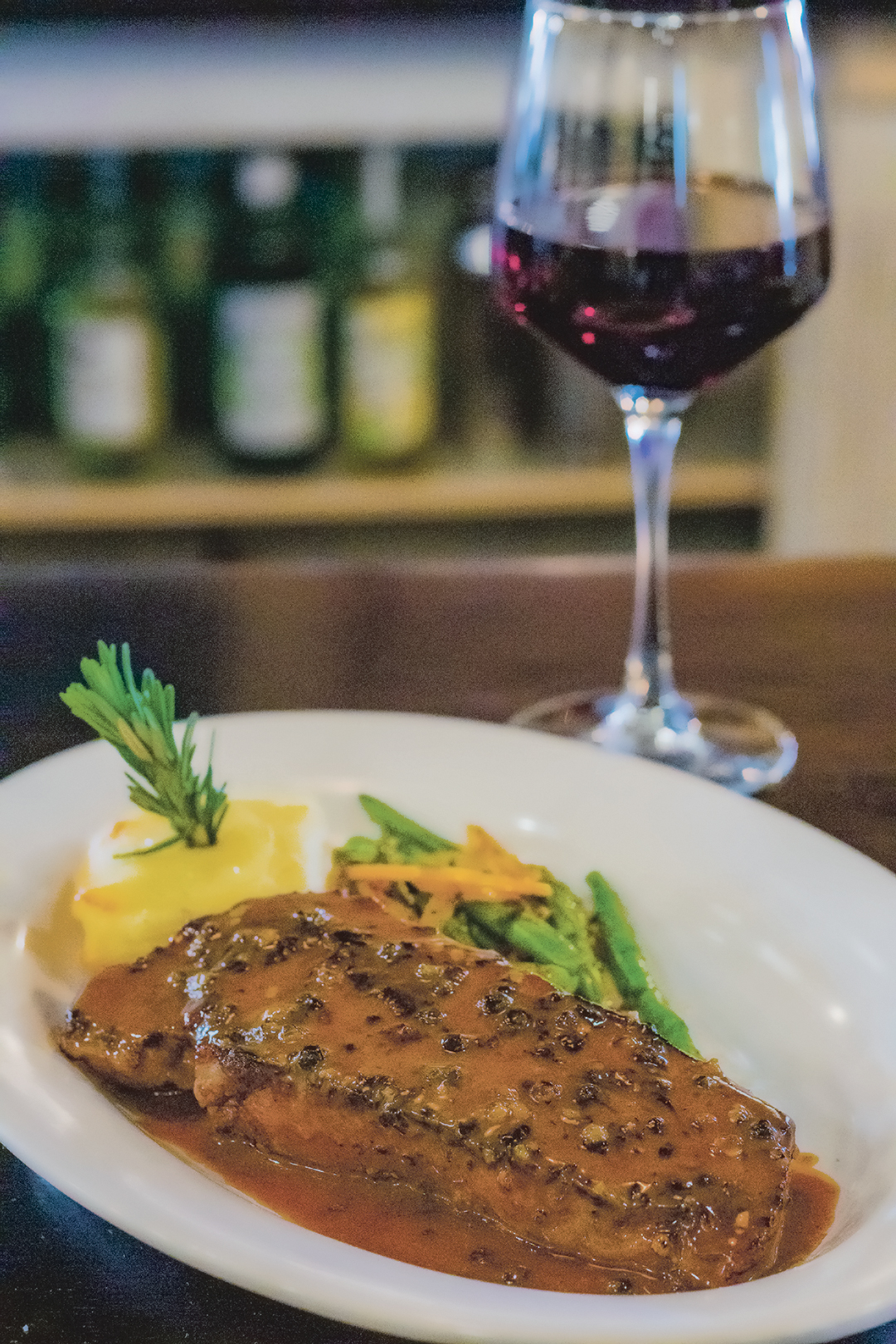
Nothing quite screams classic French cuisine like a classic French sauce. But, because of their association with haute cuisine, making these decadent accoutrements can feel somewhat intimidating to novice home cooks like me. Luckily, Chef Alain Jorand, executive chef and co-owner of Le Pommier Bistro in Eldorado, graciously agreed to demystify French sauces and teach me a simple pan sauce I can incorporate into my cooking repertoire.
“Bonjours” abound as I enter Le Pommier’s charming Parisian-style dining room and meet Jorand, originally from Champagne, France, and his American business partner and fiancée, Suzanne Eichner. (Adorable sidenote: the two met fighting over tomatoes at the Santa Fe Farmers’ Market.) The bistro has only been open a few months, but it has already found an enthusiastic following among local Francophiles and anyone who enjoys an expertly executed steak frites. Le Pommier’s menu offers some of French cuisine’s greatest hits, including savory crepes, salade niçoise, and a croque monsieur for lunch; and foie gras, steak tartare (made from local Beck & Bulow bison), coq au Riesling (chicken marinated in Riesling, stewed, and served with spaetzle), and feuilleté d’escargot (sautéed spinach, mushrooms, and snails with garlic cream sauce in a puff pastry crust) for dinner. One thing many of the dishes, even the desserts, have in common is a sauce component. “I am a sauce man,” Jorand declares. “Everything, for me, needs a sauce.”
We begin our lesson with a bit of a primer on the five foundational sauces of French cooking, known as the “mother sauces”:
1) Velouté is a smooth, “velvety” sauce made with a light roux (a thickening agent made of flour and fat cooked together in a pan) and a clear stock (poultry, fish, or vegetable). It is usually served over chicken or fish.
2) Béchamel is a white sauce made with milk and roux. On its own, it’s quite bland, so it should be incorporated into a dish with bolder flavors or transformed into a Mornay sauce by adding cheese, such as cheddar or gruyère—an integral part of a luxurious mac and cheese or croque madame.
3) Hollandaise is the only of the sauces not thickened with a roux. It consists of emulsified egg yolks, butter, and lemon juice, and is cooked over a double boiler. Rich but delicate, it can easily break, which perhaps only lends to its specialness when executed properly and poured over eggs Benedict or used as dipping sauce.
4) Espagnole is a brown sauce with great depth of flavor, achieved by first adding flour to a buttery mirepoix base to create the roux. Then, meat stock (veal or beef) is whisked in to create a gravy, before adding tomato puree, garlic, herbs, and spices. The sauce is then reduced until thick and dark. (The flavor is so concentrated that it is often the base for other sauces that are less intense, like a demi-glace.)
5) Tomate is a tomato sauce flavored with pork, onions, garlic, and herbs and spices, and traditionally thickened with a roux and/or tomato paste.
These are the sauces every French chef should know, Jorand and Eichner explain, and are the basis of hundreds of other “daughter” sauces. But they certainly aren’t the only ones. Other French classics include beurre blanc (white butter), chocolate, and the sauce Chef Jorand is whipping up for me today: a creamy green peppercorn pan sauce, which will accompany one of his favorite dishes, steak au poivre.


Jorand begins by assembling his ingredients: steak tenderloin, house-made stock made from veal bones, heavy whipping cream, butter, salt, and brined green peppercorns. The chef starts by pressing several spoonfuls of the coarsely cracked peppercorns into one side of the raw steak to make a thick crust. He then places it pepper-side down in a pan of hot neutral oil (because butter burns). He waits to salt after the initial sear, so as not to draw out the liquids prematurely. After only about a minute or so, he flips the meat and sprinkles salt generously on the side with the now-toasted peppercorns. After a couple minutes more, he flips and salts the other side. He’ll turn the steak again, giving it about eight minutes of total cook time for a medium rare. After he removes the beautifully browned beef from the pan to rest, he returns the same skillet, with all its caramelized bits, to the burner to make the sauce.
In the most exciting part of the demonstration, Jorand then splashes a healthy glug of cognac into the pan to deglaze it, and flames shoot up so high I’m amazed he still has eyebrows. He then adds about a half cup of veal stock and brings it to a simmer while scraping up the brown bits. Next, he whisks in about a quarter cup of cream, along with another spoonful of peppercorns.
As the chef stirs the pan and the liquids reduce, I finally notice that this sauce (unlike four of the five mother sauces) has no roux or thickening agent. “I don’t do roux too much,” Jorand says. “I prefer to incorporate a little butter to thicken instead of starches.” He demonstrates by adding a pat to the sauce and then gently swirling the pan to incorporate it. “You don’t want to just melt the butter, because it will separate.”
Once the sauce is thick enough to coat your spoon or finger, it is ready. Jorand places the steak on a plate next to a heavenly slice of potatoes au gratin and sautéed green beans and sweet red peppers. He then spoons a generous portion of the pan sauce over the meat. “I like to give a good amount. We often have customers request the sauce ‘on the side,’ but when the plate comes back, the sauce is always gone.”
He presents the dish to me with the requisite “voilà” and I dig in. The juicy and aromatic steak is melt-in-your-mouth juicy and the peppercorns give it a delectable kick. But the star, of course, is the rich and creamy sauce coating every bite. The richness of the veal stock and cognac is delightfully complemented by the peppercorns and the slightly tangy cream. I can’t wait to try it at home. C’est parfait.

Candolin Cook
Candolin Cook is a historian, writer, editor, and former co-editor ofedible New Mexico.She recently received her doctorate in history from the University of New Mexico and is working on her first book.


